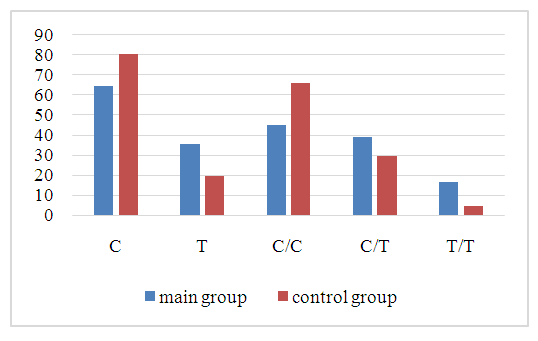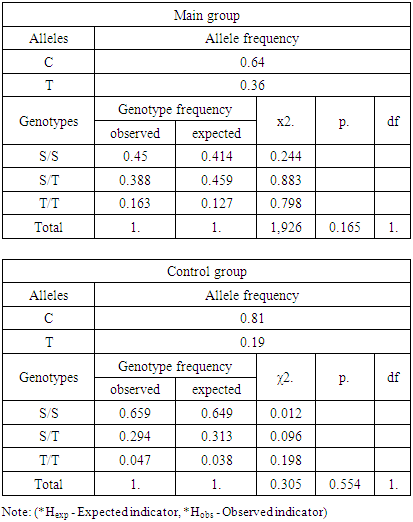-
Paper Information
- Next Paper
- Previous Paper
- Paper Submission
-
Journal Information
- About This Journal
- Editorial Board
- Current Issue
- Archive
- Author Guidelines
- Contact Us
American Journal of Medicine and Medical Sciences
p-ISSN: 2165-901X e-ISSN: 2165-9036
2025; 15(8): 2529-2531
doi:10.5923/j.ajmms.20251508.23
Received: Jul. 3, 2025; Accepted: Jul. 22, 2025; Published: Aug. 4, 2025

Assessment of ITGA-2 (C807T) Gene Polymorphism in Pregnant Women with Abdominal Delivery
Ulzhabayev Javlon Abdugani ugli1, Ahmadjonova Gulnoza Murodovna2
1Andijan State Medical Institute, Andijan, Uzbekistan
2Doctor of Medical Sciences, Associate Professor, Andijan State Medical Institute, Andijan, Uzbekistan
Copyright © 2025 The Author(s). Published by Scientific & Academic Publishing.
This work is licensed under the Creative Commons Attribution International License (CC BY).
http://creativecommons.org/licenses/by/4.0/

Background. New data have shown that the collagen-binding platelet receptor ITGA-2 (C807T) may play an important role in the pathogenesis of intraoperative hemostatic complications. One of the most effective ways to study the genetic mechanisms of platelet aggregation disorders is to identify genes that make a significant contribution to the pathogenesis of the disease. Aim. From this perspective, the purpose of this study was to assess the frequency of ITGA-2 (C807T) gene polymorphism in pregnant women with abdominal delivery. Materials and methods. Genetic studies were conducted on 80 pregnant women of the main group and 85 women with physiological pregnancy, the polymorphism of the ITGA-2 (C807T) genes was studied. In turn, we divided the 80 pregnant women of the main group into 2 groups. More precisely, in Group I we included 55 pregnant women who underwent a planned cesarean section. Group II included 25 pregnant women who underwent an emergency cesarean section. Results. From the above indicators, it became clear that the mutant T allele, in turn, significantly increases the likelihood of bleeding during surgery. The wild S allele plays a protective role. The results of our study were reliable (χ2=9.0; P=0.01). Thus, since the AUC averages 0.7, the mutant C allele of the ITGA-2 gene has relatively high prognostic efficacy in hemostatic disorders and as a marker for predicting their pathophysiology. Conclusions. Thus, the ITGA-2 gene polymorphism (C807T) in the mutant T/T genotype had an AUC of more than 60.0, which proves its important role in the risk of developing hemostatic dysfunction.
Keywords: ITGA-2, Polymorphism (C807T), Cesarean section pregnant women, Hypertension in Pregnancy
Cite this paper: Ulzhabayev Javlon Abdugani ugli, Ahmadjonova Gulnoza Murodovna, Assessment of ITGA-2 (C807T) Gene Polymorphism in Pregnant Women with Abdominal Delivery, American Journal of Medicine and Medical Sciences, Vol. 15 No. 8, 2025, pp. 2529-2531. doi: 10.5923/j.ajmms.20251508.23.
1. Introduction
- The increase in the frequency of cesarean section in recent years, associated with the expansion of indications for surgery, mainly due to relative indications in the interests of the fetus, remains consistently high [1,2,4,5,8,9,10]. In Uzbekistan, this level averages 25% during cesarean section, and reaches 25-30% in perinatal centers, with no signs of decreasing this trend.Recent studies have shown that polymorphisms of the ITGA-2 (C807T) gene, which encodes the collagen-binding platelet receptor, can play an important role in the development of intraoperative hemostasis disorders [3,6,7,9,10]. One of the main methods for studying the genetic basis of platelet aggregation disorders is to identify genes that significantly influence the pathogenesis of these conditions. Studies of genetic factors of thrombosis indicate that hemostatic cascade proteins are more common in individuals with "unfavorable" alleles [1,10]. In this regard, a decision was made to study the role of these polymorphisms in the population of Uzbekistan's women.Purpose of the research. From this perspective, the purpose of this study was to assess the frequency of ITGA-2 (C807T) gene polymorphism in pregnant women with abdominal delivery.
2. Material Methods
- Genetic studies were conducted among 80 pregnant women who delivered via cesarean section (main group) and 85 women with physiologically progressing pregnancy (control group). ITGA-2 (C807T) gene polymorphisms were analyzed. The main group was divided into two subgroups: the first subgroup included 55 women who underwent planned cesarean section, and the second subgroup included 25 women who underwent emergency cesarean section.The inclusion criteria were pregnant women• Women subject to abominate childbirth, as well as• Pregnant women with history of obstetric bleedingThe exclusion criteria were women who were noted:• Severe extragenital pathology• Hormonal pathology• Multiple pregnancy• Infectious pathology• Endocrine pathology• Autoimmune pathologyA statistical method was used on a personal computer, whichincludes data processing using the variation statistics method, calculating the following parameters for each sample: arithmetic mean (M), standard deviation (δ), error of arithmetic mean (m). Comparison of the mean values of the studied indicators was carried out according to Student's criterion (t), if the distributions obeyed the normal law. The difference between two compared quantities was considered significant if the probability of their identity was less than 5% (p<0.05).
3. Debate
- When studying the distribution of alleles and genotypes of the ITGA-2 (C807T) gene polymorphism among pregnant women who underwent planned and emergency cesarean section, as well as among women with natural childbirth, we identified the following indicators.In the main group, the mutant homozygous T/T genotype was 16.25%, the heterozygous C/T genotype was 38.75% and the homozygous C/C genotype was 45% (Figure 1).
 | Figure 1. Distribution of alleles and genotypes of the ITGA-2 gene in pregnant women of the main group |
|
4. Conclusions
- Analysis of the presented data showed that in our study, the mutant T/T genotype of the ITGA-2 gene (C807T) was associated with a significant increase in the risk of intraoperative hemostatic complications during childbirth and cesarean section (OR=3.9; 95% CI: 1.45-14.01). The C allele and the homozygous C/C genotype of the ITGA-2 (C807T) gene polymorphism do not have a significant effect on the development of intraoperative hemostasiological complications in the Uzbek population, however, the wild type of the C allele likely performs a protective function in relation to such complications. At the same time, intraoperative hemostatic complications were observed in women with the mutant T allele and T/T genotype. For a deeper understanding of the role of genes in unfavorable pregnancy outcomes, it is necessary to expand the sample of families under study and create a database that includes a list of mutations associated with bleeding.Thus, ITGA-2 (C807T) gene polymorphisms can act as risk factors for intraoperative hemostasiological complications and, as an independent genetic marker, increase the likelihood of bleeding during cesarean section in pregnant women.
 Abstract
Abstract Reference
Reference Full-Text PDF
Full-Text PDF Full-text HTML
Full-text HTML